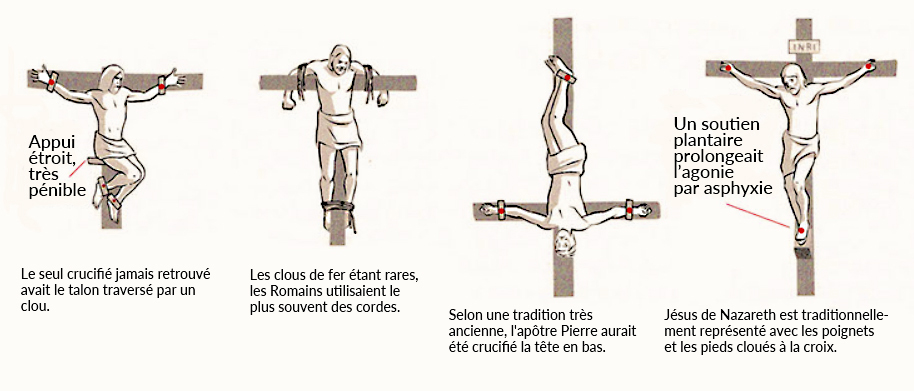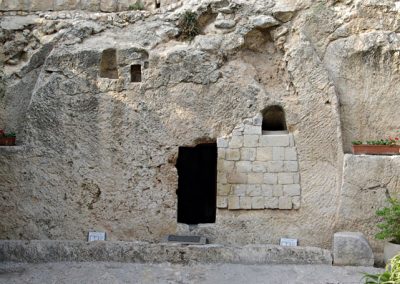
Bible, History, Archaeology
Bible,
History,
Archaeology
Jesus of Nazareth,
the crucifixion
The origins of crucifixion go back to antiquity; it was practiced by the Assyrians in its simple form, and also by the Persians.
In New Testament times, the Romans crucified slaves and men who did not have Roman citizenship. According to the testimony of Flavius Josephus, Pontius Pilate seems not to have hesitated to use this torture.
The simplest form of crucifixion is the crux simplex, where the convict is tied or nailed to a simple wooden pole (stipes crucis), driven into the ground. Sometimes there is a side bar (patibulum) attached to the post, creating a T or cross shape, as in the crucifixion of Jesus.
It is now thought that the nails are driven into the back of the wrists (the radius) and not in the palms. This allows the arms to withstand the strong pull of the body. The feet are also nailed or tied, and in some cases a kind of footrest (sedile, (Latin for «little seat»), which can momentarily relieve the weight of the body resting on it, leading to a much slower death by asphyxiation.
To hasten death, the condemned man's legs are sometimes broken so that they can no longer rest on their bindings. This is what happens in the Gospels to the two crucified on the right and left of Jesus at Golgotha.
A rare discovery
In 1968, during an archaeological dig in Civ'at Hamivtar, a neighborhood in northeast Jerusalem, the remains of two heels of an adult skeleton were found, riveted together by a large iron nail measuring about 18 cm (image below). Between the head of the nail and the right heel, debris of acacia wood is clearly recognizable; on the other hand, between the left heel and the tip of the nail, analysis reveals the presence of olive wood. The remains of a first-century crucified man, named Yehohanan (John) son of Hagqol (?), are present. Examination of the shins reveals that the crucified man's legs have been violently broken. There are no nail marks on the wrist bones, but scratches are clearly visible on the right radius. These would appear to be signs of the nails' location, which we need to place higher than the wrist.
The nail-pierced heel of a crucified man from the 1st century CE, discovered in Jerusalem in 1968. Israel Museum, Jerusalem/Montage Théo Truschel from the program «Quand l'Histoire fait dates». Arte TV.
The symbol
The cross, an object of torture, later became the symbol par excellence of Christians. Crucifixion was abolished by Emperor Constantine in the mid-4th century.
The garden tomb. One of the possible burial sites of Jesus of Nazareth © Berthold Wiener.
The garden tomb. One of the possible burial sites of Jesus of Nazareth.





